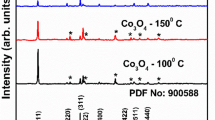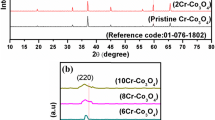Abstract
Chromium oxide has emerged as an attractive electrode material to construct high-performance supercapacitor. Despite some available reports on Cr2O3-based supercapacitors, the charge storage of Cr2O3 electrodes in alkaline electrolytes is far from being understood unlike those of other compounds of Ti, V, Mn, Fe, Co, Ni etc in periodic table of elements. Herein, the detail kinetics analyses of electrochemical behaviors of the electrode based on Cr2O3 nanoparticles in alkaline electrolyte were demonstrated in this work. We examine that there are both surface-controlled pseudocapacitance (with a contribution of 76%) and diffusion-limited redox reactions (with a contribution of 24%) for the charge storage in electrode based on Cr2O3 nanoparticles at a low sweep rate of 1 mV s−1. The identifying pseudocapacitive contribution dominates the charge storage in electrode based on Cr2O3 nanoparticles at high sweep rates, reaching up to 96% at 50 mV s−1. In addition, the assembled hybrid supercapacitor based on Cr2O3 nanoparticles as the positive electrode displays an operating voltage of 1.45 V, an energy density of 14.7 Wh kg−1, and high stability of 3000 cycles. This work will contribute to the development of pseudocapacitive electrode materials for supercapacitors.




Similar content being viewed by others
References
Dubal DP, Chodankar NR, Kim DH, Gomez-Romero P (2018) Towards flexible solid-state supercapacitors for smart and wearable electronics. Chem Soc Rev 47(6):2065–2129
Niu ZQ, Zhou WY, Chen XD, Chen J, Xie SS (2015) Highly compressible and all-solid-state supercapacitors based on nanostructured composite sponge. Adv Mater 27(39):6002–6008
Wang FX, Wu XW, Yuan XH, Liu ZC, Zhang Y, Fu LJ, Zhu YS, Zhou QM, Wu YP, Huang W (2017) Latest advances in supercapacitors: from new electrode materials to novel device designs. Chem Soc Rev 46(22):6816–6854
Wang FX, Liu ZC, Yuan XH, Mo J, Li CY, Fu LJ, Zhu YS, Wu XW, Wu YP (2017) A quasi-solid-state Li-ion capacitor with high energy density based on Li3VO4/carbon nanofibers and electrochemically-exfoliated graphene sheets. J Mater Chem A 5(28):14922–14929
Lu XH, Wang GM, Zhai T, Yu MH, Gan JY, Tong YX, Li Y (2012) Hydrogenated TiO2 nanotube arrays for supercapacitors. Nano Letter 12(3):1690–1696
Van Aken KL, Beidaghi M, Gogotsi Y (2015) Formulation of ionic-liquid electrolyte to expand the voltage window of supercapacitors. Angew Chem Int Ed 54(16):4806–4809
Wang C, Wang FX, Liu ZC, Zhao YJ, Liu Y, Yue Q, Zhu HW, Deng YH, Wu YP, Zhao DY (2017) N-doped carbon hollow microspheres for metal-free quasi-solid-state full sodium-ion capacitors. Nano Energy 41:674–680
Bonaccorso F, Colombo L, Yu G, Stoller M, Tozzini V, Ferrari AC, Ruoff RS, Pellegrini V (2015) Graphene, related two-dimensional crystals, and hybrid systems for energy conversion and storage. Science 347(6217):1246501–1246509
Koo Y, Shanov VN, Yarmolenko S, Schulz M, Sankar J, Yun Y (2015) Inverse-ordered fabrication of free-standing CNT sheets for supercapacitor. Langmuir 31(27):7616–7622
Lin TQ, Chen IW, Liu FX, Yang CY, Bi H, Xu FF, Huang FQ (2015) Nitrogen-doped mesoporous carbon of extraordinary capacitance for electrochemical energy storage. Science 350(6267):1508–1513
Khosrozadeh A, Darabi MA, Xing M, Wang Q (2016) Flexible electrode design: fabrication of freestanding polyaniline-based composite films for high-performance supercapacitors. ACS Appl Mater Interfaces 8(18):11379–11389
Liu SH, Wang FX, Dong RH, Zhang T, Zhang JA, Zheng ZK, Mai YY, Feng XL (2017) Soft-template construction of 3D macroporous polypyrrole scaffolds. Small 13(14):1604099–1604105
Ferris A, Garbarino S, Guay D, Pech D (2015) 3D RuO2 microsupercapacitors with remarkable areal energy. Adv Mater 27(42):6625–6629
Hu YT, Zhang Y, Yuan D, Li X, Cai YQ, Wang J (2017) Controllable structure transitions of Mn3O4 nanomaterials and their effects on electrochemical properties. Nanoscale Horiz 2(6):326–332
Yu F, Zhu L, You T, Wang FX, Wen ZB (2015) Preparation of chestnut-like porous NiO nanospheres as electrodes for supercapacitors. RSC Adv 5(116):96165–96169
Jin HY, Qian JS, Zhou LM, Yuan JK, Huang HT, Wang Y, Tang WM, Chan HLW (2016) Suppressing the coffee-ring effect in semitransparent MnO2 film for a high-performance solar-powered energy storage window. ACS Appl Mater Interfaces 8(14):9088–9096
Liu Y, Zhang BH, Yang YQ, Chang Z, Wen ZB, Wu YP (2013) Polypyrrole-coated α-MoO3 nanobelts with good electrochemical performance as anode materials for aqueous supercapacitors. J Mater Chem A 1(43):13582–13587
Guo Y, Li J, Chen MD, Gao GZ (2015) Facile synthesis of vanadium pentoxide@ carbon core–shell nanowires for high-performance supercapacitors. J Power Sources 273:804–809
Kaltenbrunner M, Adam G, Głowacki ED, Drack M, Schwödiauer R, Leonat L, Apaydin DH, Groiss H, Scharber MC, White MS, Sariciftci NS, Bauer S (2015) Flexible high power-per-weight perovskite solar cells with chromium oxide–metal contacts for improved stability in air. Nat Mater 14(10):1032–1039
Fister TT, Hu XY, Esbenshade J, Chen X, Wu JS, Dravid V, Bedzyk M, Long B, Gewirth AA, Shi B, Schlepütz CM, Fenter P (2016) Dimensionally controlled lithiation of chromium oxide. Chem Mater 28(1):47–54
Xiang Y, Chen Z, Chen CM, Wang TH, Zhang M (2017) Design and synthesis of Cr2O3@C@G composites with yolk-shell structure for Li+ storage. J Alloys Compd 724:406–412
Falk-Windisch H, Svensson JE, Froitzheim J (2015) The effect of temperature on chromium vaporization and oxide scale growth on interconnect steels for solid oxide fuel cells. J Power Sources 287:25–35
Kharade PM, Thombare JV, Kadam SL, Kulkarni SB, Salunkhe DJ (2017) Layered PPy/Cr2O3 as a supercapacitor electrode with improved electrochemical performance. J Mater Sci Mater Electron 28(23):17908–17916
Ullah S, Khan IA, Choucair M, Badshah A, Khan I, Nadeem MA (2015) A novel Cr2O3-carbon composite as a high performance pseudo-capacitor electrode material. Electrochim Acta 171:142–149
Zhu JK, Jiang YQ, Lu ZY, Zhao CL, Xie L, Chen LY, Duan JG (2017) Single-crystal Cr2O3 nanoplates with differing crystalinities, derived from trinuclear complexes and embedded in a carbon matrix, as an electrode material for supercapacitors. J Colloid Interface Sci 498:351–363
Chen BW, Wang YF, Li CY, Fu LJ, Liu X, Zhu YS, Zhang LX, Wu YP (2017) A Cr2O3/MWCNTs composite as a superior electrode material for supercapacitor. RSC Adv 7(40):25019–25024
Xu XY, Wu JZ, Yan N, Na HY, Li LZ, Gao JP (2015) Cr2O3: a novel supercapacitor electrode material with high capacitive performance. Mater Lett 142:172–175
Zhang BH, Liu Y, Chang Z, Yang YQ, Wen ZB, Wu YP, Holze R (2014) Nanowire Na035MnO2 from a hydrothermal method as a cathode material for aqueous asymmetric supercapacitors. J Power Sources 253:98–103
Zhang BH, Liu Y, Chang Z, Yang YQ, Wen ZB, Wu YP (2014) Nanowire K019MnO2 from hydrothermal method as cathode material for aqueous supercapacitors of high energy density. Electrochim Acta 130:693–698
Kim HS, Cook JB, Lin H, Ko JS, Tolbert SH, Ozolins V, Dunn B (2017) Oxygen vacancies enhance pseudocapacitive charge storage properties of MoO3−x. Nat Mater 16(4):454–460
Xia C, Guo J, Li P, Zhang XX, Alshareef HN (2018) Highly stable aqueous zinc-ion storage using layered calcium vanadium oxide bronze cathode. Angew Chem Int Ed 57(15):3943–3948
Wang FX, Yu F, Wang XW, Chang Z, Fu LJ, Zhu YS, Wen ZB, Wu YP, Huang W (2016) Aqueous rechargeable zinc/aluminum ion battery with good cycling performance. ACS Appl Mater Interfaces 8(14):9022–9029
Wang FX, Liu ZC, Zhang PP, Li HY, Sheng WB, Zhang T, Jordan R, Wu YP, Zhuang XD, Feng XL (2017) Dual-graphene rechargeable sodium battery. Small 13(47):1702449–1702455
Tabata S, Isshiki Y, Watanabe M (2008) Inverse opal carbons derived from a polymer precursor as electrode materials for electric double-layer capacitors. J Electrochem Soc 155(3):K42–K49
Simon P, Gogotsi Y, Dunn B (2014) Where do batteries end and supercapacitors begin? Science 343(6176):1210–1211
Lesel BK, Cook JB, Yan Y, Lin TC, Tolbert SH (2017) Using nanoscale domain size to control charge storage kinetics in pseudocapacitive nanoporous LiMn2O4 powders. ACS Energy Lett 2(10):2293–2298
Xu X, Liu W, Kim Y, Cho J (2014) Nanostructured transition metal sulfides for lithium ion batteries: progress and challenges. Nano Today 9(5):604–630
Acknowledgements
Financial supports from National Natural Science Foundation of China (21463013), Jiangxi Provincial Department of Science and Technology (20171BAB203013), Jiangxi Provincial Education Department (GJJ160290), and Open Project Program of Key Laboratory of Functional Small Organic Molecule, Ministry of Education, Jiangxi Normal University (KLFS-KF-201716) are greatly appreciated. Z.L. and Y.W. would like to express the financial support of National Materials Genome Project (2016YFB0700600), National Natural Science Foundation Committee of China (Distinguished Youth Scientists Project of 51573013) and Postgraduate Research & Practice Innovation Program of Jiangsu Province (Grant No. Kycx18_1122). The computational resources generously provided by the High Performance Computing Center of Nanjing Tech University are greatly appreciated.
Author information
Authors and Affiliations
Corresponding authors
Electronic supplementary material
Below is the link to the electronic supplementary material.
Rights and permissions
About this article
Cite this article
Li, T., Liu, Z., Zhu, L. et al. Cr2O3 nanoparticles: a fascinating electrode material combining both surface-controlled and diffusion-limited redox reactions for aqueous supercapacitors. J Mater Sci 53, 16458–16465 (2018). https://doi.org/10.1007/s10853-018-2743-0
Received:
Accepted:
Published:
Issue Date:
DOI: https://doi.org/10.1007/s10853-018-2743-0




